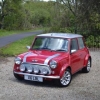there are no performance changes to a sportpack mini.
sportpack cars have a few differances.
So what is the difference between a Cooper and Cooper sport on an MPI? I realize that all Cooper Sport models have the sportspack option and that some Cooper models have the sportspack option.
The whole "Cooper Sports" thing is pretty confusing. Here's my take on it based on Mini World magazines of the time, Chris Rees's excellent
Complete Classic Mini and my own memory(!). I hope anyone reading this will correct any inaccuracies:
There was a limited edition Cooper Sports model produced by Rover in 1998. It was offered in Brooklands green or black paintwork with dark green leather interior. It also had distinctive BMC rosette decals and a V flash above the front side indicator. The engine was the standard 63bhp 1275 MPi unit. Interestingly, although it had sportspack wheels and arches and other features, it only had two auxiliary front lamps. Only 100 of these cars were made.
When the four Mini runout models were announced in early 2000, the Cooper Sports name was used again for one of these. These were basically a Sportspack Mini with a few special features: The seats were black and nickel leather with black piping, the upper dash was black leather and the steering wheel nickel and black leather. The door fittings and gearknob were alloy and the dash had a engine-turned-alloy-like finish. The engine was the standard 63bhp 1275 MPi. The paint choices available were standard Mini colours, except black. The Cooper Sports was only produced for the UK market.
John Cooper Garages took the Rover Cooper Sports runout model and modified it to produce the
John Cooper Garages Mini Cooper Sports SE. These were available only in Tahiti Blue with silver roof and stripes. Coopers added a few distinctive features, such as a flip petrol cap, but the big difference was the specially tweaked (S Works) engine that produced 90bhp, had a top speed of 102mph and did 0-60mph in 8.9 seconds. These models were announced shortly after the Rover runout models.
In answer to an earier question about MPi production figures: From 1996, 65,695 Minis were produced. However, a large number of these were for the Japanese market and these had SPi, rather than MPi engines fitted (to allow space for air conditioning) so it's hard to say how many of the total were actually MPis. Maybe someone else can provide more definitive figures.


















